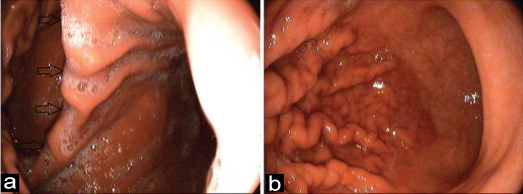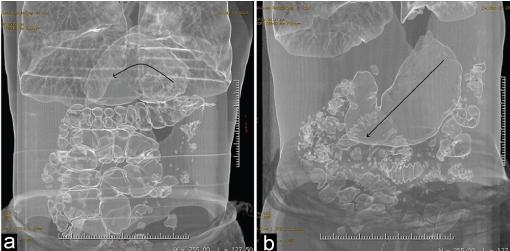Chronic Gastric Volvulus – Diagnosed on Endoscopy
Vinoth Boopathy1, Padhmini Balasubramanian2
1 Associate Professor, Department of Medical Gastroenterology, Aarupadai Veedu Medical College and Hospital, Puducherry, India.
2 Associate Professor, Department of Radiology, Aarupadai Veedu Medical College and Hospital, Puducherry, India.
NAME, ADDRESS, E-MAIL ID OF THE CORRESPONDING AUTHOR: Dr. Vinoth Boopathy, S2, Malar Daffodil Apartments Bharathiyar Street 3rd Cross, Jayamoorthy Raja Nagar-605004, Puducherry, India.
E-mail: drvinoth@gmail.com
Gastropexy, Organoaxial rotation, Twisted stomach
A 40-year-old male presented with dull aching, constant epigastric pain of three months duration, pain was aggravated on and off for few hours, and later reduced in intensity by itself. An upper gastrointestinal endoscopy showed an abnormal axis of the stomach, with a twist [Table/Fig-1] and intubating the pylorus was found difficult. However, on withdrawal from the duodenum, the orientation of stomach appeared normal. A possibility of gastric volvulus was considered and a contrast-enhanced computed tomography of abdomen was done. This it showed inversion of greater and lesser curvature, with gastric rotation along the long axis consistent with an organoaxial type of gastric volvulus [Table/Fig-2] [1]. The patient underwent gastropexy and was symptom free on follow up. Chronic gastric volvulus is a rare and often underdiagnosed condition in view of its spontaneous reversibility and an unpredictable nature at the time of evaluation [1,2]. A slight hint of an abnormal orientation of the axis of the stomach while performing an endoscopy should raise the suspicion of this condition.
Endoscopic picture showing: a) Abnormal axis of the stomach with a twist (black arrows) when viewed from just beyond oesophagogastric junction in our patient with volvulus; b) When compared to the usual normal axis of stomach in a normal patient.

Computed tomography volume rendered reconstructed image showing: a) Twisting of the stomach (curved black arrow) along the long axis, consistent with organoaxial type of volvulus; b) When compared to the usual normal axis of the stomach (straight black arrow) taken from another patient.

[1]. Wasselle JA, Norman J, Acute gastric volvulus: Pathogenesis, diagnosis, and treatmentAm J Gastroenterol 1993 88(10):1780-04. [Google Scholar]
[2]. Lee HY, Park JH, Kim SG, Chronic gastric volvulus with laparoscopic gastropexy after endoscopic reduction: A case reportJ Gastric Cancer 2015 15(2):147-50. [Google Scholar]